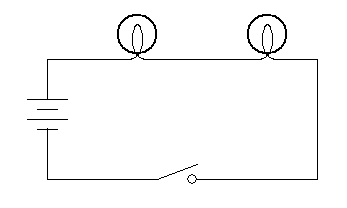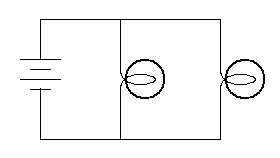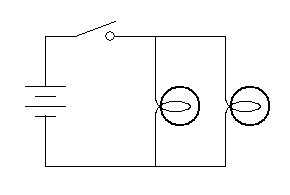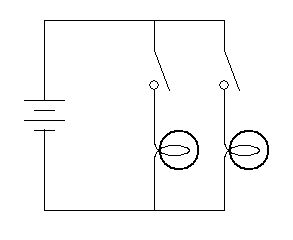Series & Parallel Circuits
Introduction So far we have discussed circuits with only two components, a source of current (such as a battery) and a single resistance (such as a lightbulb or resistor). Of course, most circuits are more complex: they contain a variety of components interconnected in a variety of ways. The two most fundamental ways of connecting devices are called series and parallel.
to do as you read
Series Circuits In a series circuit, devices are strung together one after another so that whatever current flows through one must flow through the other, each in turn.
In this circuit, the current that comes out of the battery passes through both lamps. Neither lamp feels the full voltage of the battery. How much current comes out of the battery is determined by the total resistance of the circuit.
Resistances in series add together. Stated more mathematically,
Rtotal = R1 + R2 + R3...
If a switch is added to a series circuit, then it controls (turns ON and OFF) everything in that circuit. Adding a switch to the above circuit gives us the diagram below. If the switch is open, no current will flow at all. The switch could be placed anywhere in the circuit and it would have the same effect.
Parallel Circuits In a parallel combination there is a junction, a "fork in the road". Examine the example circuit, below. The current entering the junction is split, with some of it leaving in one direction and the rest leaving the other way. Only part of the current flows through each device. On the other hand, each device "feels" the full voltage of the battery.
If resistors are combined in parallel, the total resistance becomes less, because the current has alternate paths. The mathematical rule is that the inverse of the resistances add together.
1/Rtotal = 1/R1 + 1/R2 + 1/R3...
If we want to control these lamps with switches, we have options. One way is to add a switch like this...
In the above circuit, the switch controls all the current flowing out of the battery and into the junction. If open, both lights will be OFF. When closed, it allows the current to flow and both lamps will glow. On the other hand, if you want to control the lights individually, then you need two switches, hooked up like this...
Each switch in this circuit controls one, and only one, of the lamps. In describing this circuit, you would say that each switch is "in series" with a lamp, and the two switch-lamp combinations are "in parallel" with each other.
Example
Let's say you have two resistors. R1 = 10 Ωand R2 = 20 Ω.
If they are connected in series, their combined resistance is 30 Ω. Easy, right?
If they are connected in parallel, figuring our their combined resistance is a little more complicated.
1/Rtotal = 1/10 Ω + 1/20 Ω = 3/20 Ω.
Remember, this is the inverse of the combined resistance, so invert to find that...
Rtotal = 20/3 Ω = 6.7 Ω
1. Draw a circuit with a 6.0-volt battery and two resistors (330 Ωand
4.7kΩ ) in series. (a) What is the total resistance
of the circuit?
(b) What is the current flowing out of the battery?
(c)
What is the current flowing through the 330 Ωresistor?
(d) What is the current flowing through the 4.7kΩ resistor?
(e) What is the voltage across the 330 Ωresistor?
(f) What is the voltage across the 4.7kΩ resistor?
Assume the wires have no resistance. Solution video
2. Draw a circuit with a 6.0-volt battery and two resistors (330 Ωand 4.7kΩ ) in parallel. Answer the same questions as in #1. Solution video
Another example
Let's say you have three resistors. R1 = 500 Ω, R2 = 2 kΩ, and R = 5.6 kΩ.
If they are connected in series, their combined resistance is 8100 Ω, or 8.1kΩ.
If they are connected in parallel, then
1/Rtotal = 1/500 + 1/2000 + 1/5600= 0.002679
Invert to get the final result....
Rtotal = 373 Ω.
Additional Practice
For these problems, show your work. If there is a calculation, show the equation you are using, plus the numbers plugged in (with units). If the answer doesn't require a calculation, write a one-sentence explanation.
3. Draw a circuit with a 12-volt battery and two resistors (5.6kΩ and 220 Ω) in series. (a) What is the total resistance of the circuit? (b) What is the current flowing out of the battery? (c) What is the current flowing through the 5.6 kΩ resistor? (d) What is the current flowing through the 220 Ω resistor? (e) What is the voltage across the 5.6 kΩ resistor? (f) What is the voltage across the 220 Ω resistor? Assume the wires have no resistance. Solution
4. Draw a circuit with a 12-volt battery and two resistors (5.6 kΩ and 220 Ω) in parallel. Answer the same questions as in #1. Solution
5. Draw a circuit with a 12-volt battery, a 1.0kΩ resistor in series, and two resistors (5.6 kΩ and 220 Ω) in parallel. (a) What is the total resistance of the circuit? (b) What is the current flowing out of the battery? (c) What is the current flowing through the 1.0kΩ resistor? (d) What is the voltage drop across the 1.0kΩ resistor? (e) What is the voltage across the two parallel resistors? (f) What is the current flowing through the 5.6kΩ resistor? (g) What is the current flowing through the 220 Ωresistor? Solution video




